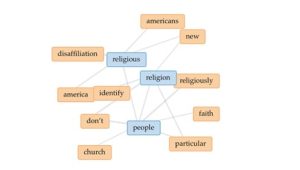https://voyant-tools.org/?corpus=7e21d3b4fe9e3d7e09bddbdc41e914bf&visible=125&panels=cirrus,reader,trends,phrases,correlations&view=Cirrus
For this assignment, I compared two texts Irish mythology and The Characteristics of Irish Folklore. I tried to play around with the graphs and charts but I think the cirrus (word trend) was the best visual representation for showing trends between these two. Since the subject I’m looking at is vast and there are multiple interpretations, I find the words commonly associated with both texts to be intriguing and very telling regarding Celtic folklore. I’m interpreting the data by looking at words most commonly used \ to better understand what folklore is to begin with. Words such as tradition, local, dead, custom, gods, power, and stories are very indicative of the culture embedded in mythology.
note: there are a few words in there only because they come from the source such as Jstor, NOV, 2022. I couldn’t figure out how to remove them completely. I tried to go in and select certain words to show up but the visual did not match that so disregard those until I can figure out how to remove them from the visual.

